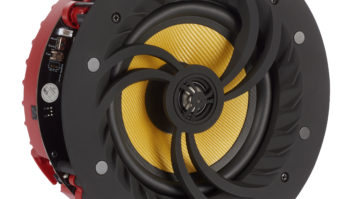DENVER— Multiroom audio systems using wireless- or powerline-network technology to transport audio and control signals are streaming into the CEDIA Expo.
In some cases, the systems are designed to integrate with traditional wired multiroom audio systems to stream music to rooms impractical to reach by wire. In other cases, they’re designed to network
A/V components with PC-stored content. In any case, many of the new products will appeal to retailers or installers interested in expanding their base of potential multiroom audio customers, particularly to tap into the retrofit market now that new-home starts are in the dumpster.
At the show, Russound is unveiling a powerline-based Avenue Zone Extender system, which uses powerline-network technology to extend the reach of its custom-installed CAV6.6-based multiroom audio system to rooms where home Denon is showing recently unveiled products — including multizone A/V receivers, a tabletop music system and an iPod-docking network client — with built-in Wi-Fi to stream content from PCs and network-attached storage (NAS) devices.
Magic Home Entertainment of Denver plans to demonstrate its second-generation moodSeer system, which
consists of a multizone HDD music server capable of distributing audio simultaneously to 36 Ethernet-networked clients or simultaneously to six wireless clients that incorporate 802.11g.
For their part, Soundcast is unveiling a wireless stereo amplifier/client that streams music from a PC or other audio component connected to a companion wireless transmitter. And Sonos is demonstrating its wireless mesh-network system for distributing PC-based music and Internet radio, including the recently added Sirius Internet Radio service.
Here are the details:
Denon: The company’s expanded wired and wireless-networking effort includes the brand’s first products with built-in Wi-Fi to stream music and photos from a PC and to access Internet radio without using a PC. The Wi-Fi products — which incorporate 802.11b/g — include two A/V receivers at a suggested $2,499 and $5,200; the S52 one-piece tabletop “network-music system” with HD Radio, XM port and integrated iPod dock at a suggested $699; and a combination iPod dock/network client. This device, at a suggested $229, connects an iPod to any A/V system and networks the system with a PC.
Three networked audio products using a wired Ethernet port include a $1,599 A/V receiver and a $179 iPod dock/network client.
All told, eight new products are network capable compared to three Ethernet-connected A/V receivers in the brand’s previous product lineup. The networked devices are also DLNA-certified so they can access a DLNA-certified networked-attached storage (NAS) device while a networked PC is off.
Magic Home Entertainment: The moodCenter M1 HDD server with CD slot will be upgraded to 250GB from 200GB in its base configuration, with expandability to 500GB, and an M2 model with up to 1TB of storage and RAID technology will be shown.
They transmit audio over wired Ethernet networks and via wireless 802.11g to tabletop clients called moodSpots, which connect to existing stereo systems. The server can be controlled from other rooms via the moodBeamer wireless-RF handheld touchscreen, which displays the server’s user interface. The company expects here at CEDIA to announce partnerships enabling other companies’ home-automation touchscreens to control the server.
The moodSeer and M2 servers will feature a new user interface that includes large touchscreen buttons and text for clarity and finger control, search by album art, ability to jump to any song in the queue, improved remote support by installers or by Magic Home, faster quick search and a new process for faster and easier saving of playlists, the company said. Like before, music can be ripped through the server’s CD transport or transferred via networked PC.
The systems also deliver Internet radio stations to each room, including such subscription services as aLive365.
The upgraded M1 and the M2 are available Sept. 5 at pricing that was unavailable at press time.
Soundcast: The latest additions to the company’s wireless audio selection are the Universal AudioCast Transmitter (UAT) and companion AmpCast receiver/client with built-in 2×30-watt amplifier. They’re due in late 2007 or early 2008.
Like their predecessors, these devices are promoted as offering interference-free wireless audio with a range said to be longer than that of any other wireless audio system — up to 150 feet indoors through walls — despite FCC power limits.
The 7-inch-tall 2.4GHz transmitter, when connected to a PC’s USB port, streams PC-based music to AmpCast-connected speakers. The transmitter is also compatible with the company’s other currently available clients, including a model with built-in amplifier and speakers and a model lacking amplifier and speakers.
Via on-chassis controls, the AmpCast will also remotely control the following basic PC-audio playback functions: track forward, track back, pause and play. AmpCast will also come with an IR remote that’s also planned to control those functions.
The UAT and AmpCast devices are compatible with all major PC-based music player applications without the need to install drivers on the PC. The transmitter connects to the PC via USB, which will also supplies power.
The new transmitter can also be connected to any audio source component, including the surround-channel outputs of an A/V receiver, via line-level RCA inputs. When a UAT is connected to a traditional source component such as a CD changer or music server, however, the AmpCast will not remotely control song selection.
In a home theater application, A UAT-AmpCast combination will deliver
surround channels wirelessly to AmpCast-connected surround speakers. Power is available through a wall-wart power supply.
Soundcast already markets transmitters intended mainly to dock with iPods and MP3 players. When these transmitters are connected to a PC, they will stream PC audio, but the clients won’t control basic playback functions.
Prices on the new models haven’t been set, but an existing iCast iPod-docking transmitter and retails for a suggested $299. Additional iCast receivers, which lack amplification, are $129 each.









